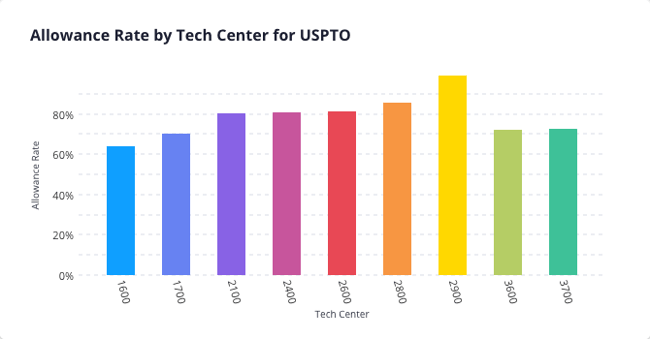When it comes to patent prosecution, knowing your examiner’s allowance rate can give you a great insight into the road that lies ahead.
By understanding how an examiner has performed in the past, you can manage client expectations while structuring a prosecution strategy based on historical trends.
To help with this, here is the latest in our recurring series identifying the 25 USPTO examiners with the most skeptical eye toward the patent applications that cross their desks.
To determine our list, we analyzed the allowance rates of examiners who had reviewed 100 or more applications disposed between 2017-2021. We limited this analysis to utility and plant applications, excluding design patents, reissues, re-examinations, and provisional applications. Additionally, we excluded Supervisory Patent Examiners from this analysis. This analysis was conducted based on public data available in April 2023.
Of the nearly 7,400 examiners that fit our parameters, 139 had less than a 25% allowance rate, and 865 had less than a 50% allowance rate. The current average allowance rate at the USPTO is 74%.
In prior years we looked at the top 10 examiners. This year we’re expanding by highlighting the top 25, which may impact some of these year-to-year trends:
- Examiners Kevin Worrell, Rodney M. Henry, and Arunava Chakravarti, Krupa Shukla and Kimberly L. Evans have all been featured on our lists of Most Difficult Examiners before, though it is worth noting that in previous iterations we only named the Top 10.
- Examiners Michael J. Sittner, Kiersten Summers, Darlene Garcia-Guerra and Matthew Divelbiss fell outside of the Top 10 this year, but still made our expanded list of 25.
- Making their first appearance in the Top 10 are Lance White, Daniel Lane, and Steven Pohnter.
Similar to previous years, the majority of examiners listed, 17 out of the 25, work in Technology Center 3600, historically the category most impacted by Alice rejections. With a reputation as the “patent pit of despair,” TC 3600 was seen for many years as a place where software patent applications went to die. And while most of our difficult examiners work in this "catch-all" technology center, it's worth noting that TC 3600 is not the most difficult at the USPTO. According to the latest public data available in Juristat, the technology center with the lowest average allowance rate is TC 1600.

This year, four of the 25 examiners are from Art Unit 3689, which is a miscellaneous workgroup that examines electrical apparatus and corresponding methods that perform data processing operations, among other things.
An examiner’s allowance rate is just one piece of the puzzle when it comes to structuring a successful, data-driven prosecution strategy. For example, looking at Examiner Michael Sittner’s record in Juristat, you’ll see that although he may still be considered difficult compared to his art unit, his allowance rate is actually more favorable with those who interview. Juristat’s examiner reports include this valuable metric and more.

With examiner analytics, attorneys can create detailed prosecution strategies for every examiner at the USPTO, with insight into interview and RCE success rates, end-loading rates, and more. Practitioners can specifically tailor their responses based on how examiners have reacted to past, similar applications.
Want some one-on-one guidance? Let’s set up a time to chat today.
(gradient).webp)

